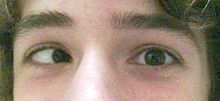This article needs additional citations for verification. (September 2019) |
| Esotropia | |
|---|---|
 | |
| Specialty | Ophthalmology |
Esotropia (from Greek eso 'inward' and trope 'a turning'[1]) is a form of strabismus in which one or both eyes turn inward. The condition can be constantly present, or occur intermittently, and can give the affected individual a "cross-eyed" appearance.[2] It is the opposite of exotropia and usually involves more severe axis deviation than esophoria. Esotropia is sometimes erroneously called "lazy eye", which describes the condition of amblyopia; a reduction in vision of one or both eyes that is not the result of any pathology of the eye and cannot be resolved by the use of corrective lenses. Amblyopia can, however, arise as a result of esotropia occurring in childhood: In order to relieve symptoms of diplopia or double vision, the child's brain will ignore or "suppress" the image from the esotropic eye, which when allowed to continue untreated will lead to the development of amblyopia. Treatment options for esotropia include glasses to correct refractive errors (see accommodative esotropia below), the use of prisms, orthoptic exercises, or eye muscle surgery.
- ^ "Esotropia Origin". dictionary.com. Retrieved 1 February 2016.
- ^ "Esotropia". American Association for Pediatric Ophthalmology & Strabismus. January 2016. Retrieved 5 September 2019.